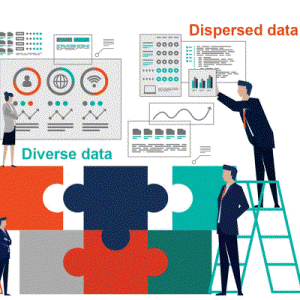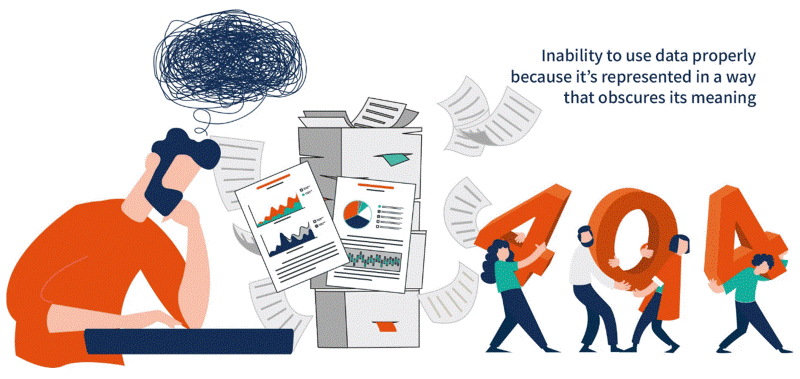Knowledge Graphs Redefining Data Management for the Modern Enterprise

In the current data management landscape, enterprises have to deal with diverse and dispersed data at unimaginable volumes. Among this complexity of siloed data and content, valuable business insights and opportunities get lost.
Not surprisingly, the last decade has witnessed a paradigm shift in enterprise data management, leading to a rise in leveraging knowledge graphs. Providing unified information access, flexible data integration and automation of data management tasks, knowledge graphs have a huge impact on many systems and processes across various industries.
The value proposition of knowledge graphs
One of the key advantages of knowledge graphs is their ability to integrate and unify data from diverse sources. In this way, data is no longer fragmented or potentially lost across different systems or departments of an organization. Instead, it can be viewed, explored and analyzed from a single access point.
Knowledge graphs can also act as a central hub that brings together not only the actual data, but also metadata. This enables enterprises to have a holistic view of all information and better understand the relationships between its different pieces. This is a core component of most data fabric-based implementations.
Knowledge graphs also ensure that data is always represented consistently. Regardless of its original format or source, data is transformed and unified in a way that provides all users with a common framework for understanding and working with it.
Using semantic modelling techniques (such as ontologies and controlled vocabularies) allows knowledge graphs to define precise meanings and relationships between the data. This solves ambiguity issues that plague traditional data management systems.
Another unique ability of knowledge graphs is that they can enhance their proprietary information by leveraging global knowledge as context for interpretation. This means that in addition to the data contained within the graph, external knowledge sources can be integrated to provide a richer and more comprehensive understanding of the data.

Rising above the challenges
The value of data depends on our ability to use it effectively. The vast amounts of data enterprises have today need to be processed, understood and leveraged in realtime. Traditional approaches to data management are no longer sufficient to handle current demands. More and more enterprises are realizing the importance of managing their data differently to reduce costs, improve maintenance and unlock potential revenue and gain competitive advantage.
Knowledge graphs provide a viable solution to many data management challenges. They are suitable for every organization, regardless of its size, and can easily handle the diversity and lack of centralized control inherent in modern data ecosystems.
Let’s have a look at some of the challenges enterprise data management faces today and how knowledge graphs address them.
Multiplicity of data sources and types
Traditionally, data representation is tightly coupled to specific formats, which dictate how the data is organized and stored. As a result, information and communication technology infrastructures are required to support a wide range of data formats and types spread across various systems. This also includes legacy systems that are used in ways beyond their original purposes.
Knowledge graphs address this problem by providing a higher-level abstraction for representing data. This allows the format of the data to be decoupled from its purpose or intended use. It’s a more flexible approach towards data modelling, where concepts are represented as nodes and relationships between concepts are represented as edges. Since the graph structure is not tied to any specific format, it becomes easier to integrate data from different sources and systems, which enhances data interoperability.
Also, as the purpose or use of data changes over time, the underlying model can be modified without the need to restructure the data completely. This flexibility enables enterprises to better respond to changing business needs or data requirements.
Disconnect between data and the real-world
Relational databases have significant limitations when it comes to organizing and accessing information in an intuitive manner. “Relational databases” are an oxymoron. Relationships are not first-class citizens in such databases. Their rigid tabular structure fails to capture the inherent complexities and rich interconnectedness of real-life data, which often leads to compromises, simplifications and impedance mismatch.
As a result, traditional data management solutions often rely on human efforts to organize real-world information in a way that conforms to the available software. This requires extensive upfront planning and schema design to determine how the data would be stored, connected and queried.
In contrast, knowledge graphs organize information intuitively. By enabling an expressive and flexible representation of data, graph structures capture the relationships between different pieces of information and provide richer context. This empowers enterprises to work with data in a way that closely mirrors their understanding of the domain. It also leads to better insights, decision-making and utilization of data resources.
According to McKinsey, data professionals in most organizations spend 25-30% of their time finding and searching for relevant data. Knowledge graphs help semantically discover, find and explore relevant data, using Linked Data principles. By leveraging shared vocabularies and standards, data can be semantically linked across different sources making it possible to traverse across the connections to find the information they need.

Lack of meaning
Many enterprises fail to make proper use of their data because it’s represented in a way that obscures its meaning and the underlying modelling assumptions. This restricts the usability of the data to systems where these assumptions are explicitly hardcoded. It also makes it difficult to integrate data with other systems or leverage it in different contexts.
The representation of data in a knowledge graph conforms to a formal meaning that can be interpreted unambiguously by both humans and machines. This enables a clear understanding of its content. This formalism of semantics powers automated reasoning, which leads to new data-driven insights as well as identifying hidden patterns or relationships.
By leveraging the semantic richness of knowledge graphs, enterprises can better perform important tasks such as answering complex queries, making predictions or generating recommendations. They can track data as it flows through the enterprise, monitor its quality, discover errors, and trace them to the source, reducing bad data quality and data duplication. Knowledge graphs provide high-quality data based on enriched and linked metadata.
Rigid and brittle schemas
The traditional approach in data management calls for defining an exhaustive data schema upfront, based on a presumed understanding of all requirements. However, it’s next to impossible to fully grasp the intricacies of a business case and to capture all possible attributes and relationships in a single schema from the outset.
In addition, the dynamic nature of businesses and evolving data needs make it inconceivable to expect a single schema to remain applicable and valid for long periods. The constantly changing technologies, market trends and business requirements demand adaptable data management approaches.
The good news is that knowledge graphs have the ability to model data in a flexible and extensible manner. As new data requirements arise, they allow adding or modifying schema elements, without a complete overhaul of the existing structure. This enables enterprises to keep pace with evolving business needs and future demands.
Data silos
Data silos are one of the biggest hurdles to using data efficiently and enterprises often revert to using point-to-point data integration as a quick workaround. However, each integration significantly increases the development time, complexity, resources and effort, slowing down crucial business processes that rely on timely and accurate information.
Most importantly, this approach often fails to address the fundamental problem. Data silos occur when data is isolated and confined within specific systems or departments. Such integrations only establish direct connections between selected systems, leading to a fragmented integration landscape.
The interconnected nature of knowledge graphs, on the other hand, allows enterprises to reuse their existing data assets more effectively and efficiently as well as to easily incorporate external third-party data sources. This empowers them to leverage their proprietary knowledge into the context of global information and enhance business analysis, decision-making and innovation.
In addition, the use of open standards when building knowledge graphs not only ensures interoperability and facilitates the integration of data from multiple domains, but also avoids proprietary formats and vendor lock-in. They connect entities between records in the different datasets to get a 360-degree view. Knowledge graphs excel in providing an entity-centric view that encompasses data across heterogeneous data sources
Expensive data management
As we already discussed, dealing with various data formats and types, reliance on manual efforts, and never-ending data integration projects puts a strain on the overall cost and timelines of enterprise data management.
Knowledge graph approaches offer many cost-effective benefits. For example, the ability to reuse data allows enterprises to better utilize their existing data assets across different applications, projects and teams. Bootstrapping systems with Linked Open Data reduces the costs of data acquisition and maintenance. Flexible graph models eliminate the need for exhaustive (and expensive!), future-proof schema designs and redesigns. The list can go on and on.
Limited time and resources
For most enterprises across all industries, the majority of data remains untapped, invisible, inaccessible and only a small fraction of it is being actively used. This disparity between the vast amount of data and the limited capacity to process it hinders their ability to extract meaningful information and derive actionable insights.
By capturing the rich semantic relationships between concepts, knowledge graphs enable inference capabilities, complex analysis and discovery of hidden patterns. They form a robust backbone for every artificial intelligence and analytics platform and empower users to uncover insights locked in the data and do it in real time.
To wrap it up
The abundance of data requires a data model that is aligned with our complex understanding of information, domain and context. To make data smart, we need to abandon inflexible data schemas and choose data models that can represent the real world with its rich and intricate relationships. When this is done in a machine-readable format with formal semantics, it enables automated reasoning, which complements and facilitates human expertise and decision-making.
Semantic knowledge graphs fulfill these requirements and find applications in many data and information-intensive services across various industries. By adopting them as a foundational component of their data management strategies, enterprises can navigate the complexities of the modern data landscape and make their data and decisioning smarter, faster and data-driven.
Gergana Petkova is Content Manager at Ontotext. Originally published Here.
